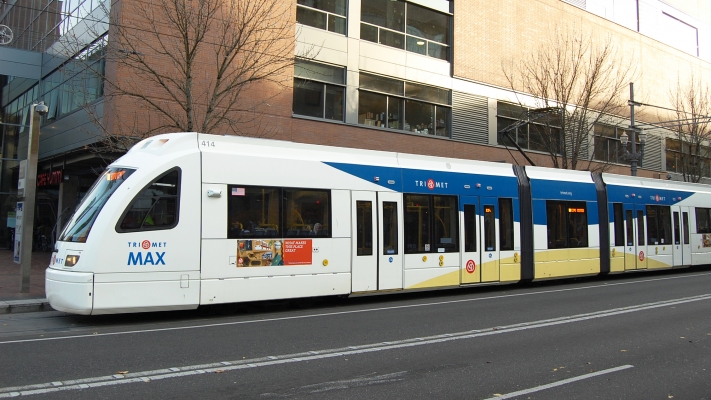Guidelines lead to parking glut at transit-oriented developments

Saddling transit-oriented developments with parking requirements better suited to typical suburban developments can make housing and office space near transit scarce and overly expensive. That’s one implication of a recent NITC research report "Trip and Parking Generation at Transit-Oriented Developments" examining driving and parking at these centers.
It makes sense that transit-oriented developments—dense, walkable centers close to transit that combine residential, commercial and office uses—would generate fewer car trips and need less parking than other development types. But until now, no one has found out how much less parking.
NITC researcher Reid Ewing of the University of Utah took up the challenge and reveals the answer in a report: a lot less. The developments Ewing’s team studied generally generated less than half the driving, and required fewer than half the parking spaces, than standard guidebooks predict. They presented some of their findings Jan. 10 during the annual meeting of the Transportation Research Board in Washington, D.C. Learn more about the conference or download the paper.
Ewing’s team studied transit-oriented developments in five United States metropolitan areas and found the developments produced just one-third to two-thirds of the vehicle trips predicted by the Institute for Transportation Engineers’ Trip Generation Manual. Even the most auto-oriented development in the study, which supplies abundant free parking, still generates fewer than 70 percent of the auto trips the manual predicts.
“These numbers,” Ewing said. “They’re more impressive than I would have imagined.
“These are Americans,” he said. “But if you put them in a setting where all they have to do is take and elevator down from their apartment to a plaza and walk under a minute to a platform to wait for a train, the vehicle trip reductions are so dramatic it surprises me.”
The research also shows that ITE Parking Generation manual misses its mark for a wide margin for these development types. A typical study site, in Redmond, Washington, supplies about half the parking spaces the manual recommends and fewer than three-quarters are even occupied at the busiest hour.
At every site studied, the peak parking demand was less then half of what the ITE manual suggests. “If you build to the ITE guideline, only 41 percent of your spaces will be filled—at the peak hour,” Ewing said of Redmond. The other sites ranged from 19 to nearly 48 percent.
The parking revelation is among the most important in this study, Ewing said. “That’s what we haven’t known as much about, in that you could oversupply parking by 100 percent if you followed the ITE Parking Generation manual as everyone does.
“That’s phenomenally large.”
The implications of that oversupply could also be huge. Building unneeded parking lots and garages wastes money and land developers could use to supply more housing, office and commercial space. That restricts the supply of those uses, driving up the cost to live, work and shop near transit.
Although transit-oriented developments were first described in the early 1990s, the thin body of research on driving and parking hasn’t given planning and permitting authorities enough data to drop the inapt parking requirements. “It floors me that it’s taken all this time to generate hard numbers that other people can use as they plan additional TODs,” Ewing said.
Such research takes a lot of time and a lot of money, Ewing acknowledges. He’s sent out crews of 30 people for data collection at developments.
Ewing hopes his research will bolster developers, planners and policymakers eager to make better use of land near transit. At the very least, showing how big a gap exists between guidelines and actual use might embolden people to make changes.
“If you have a surplus of parking in the amount of 60 percent, it makes sense to cut back,” Ewing said. “You might not cut back 60 percent, but you might cut back 20 or 30 percent.”
A journal article stemming from this research is scheduled for publication in Landscape and Urban planning (Vol. 160).
Smart Growth America is also preparing a summary report of the NITC project and will host a webinar Jan. 31.
- Read more of our TRB coverage
- Download the conference paper or the full research report
